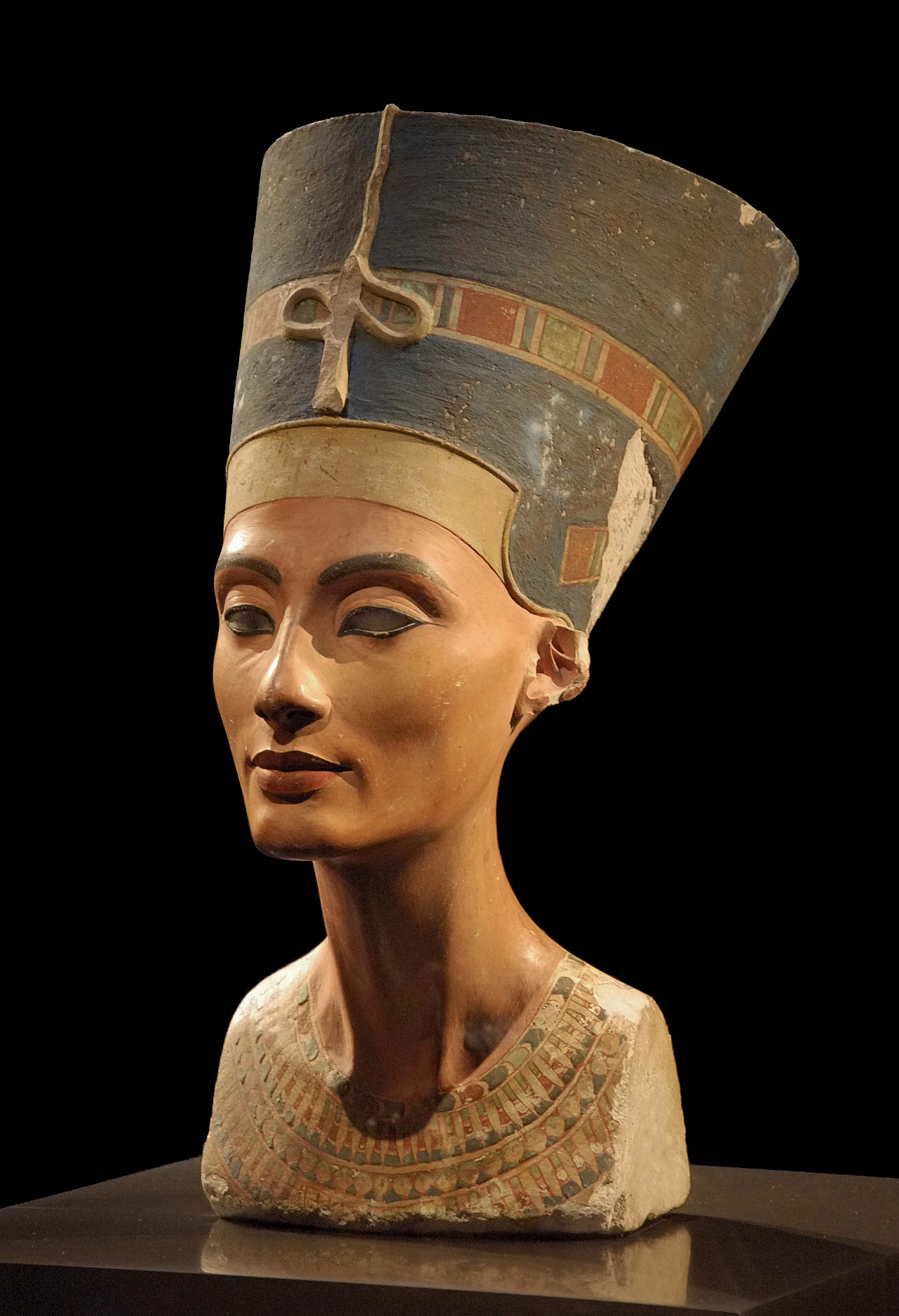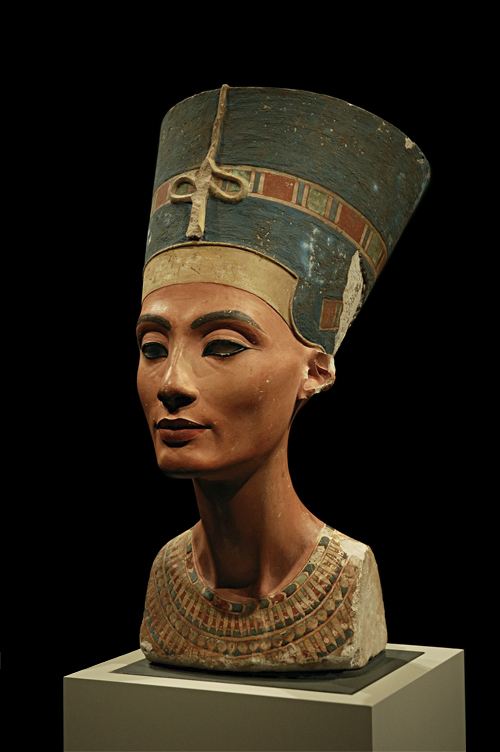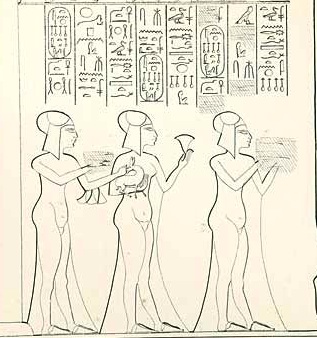|
Nefertiti
Neferneferuaten Nefertiti () ( – c. 1330 BC) was a queen of the 18th Dynasty of Ancient Egypt, the great royal wife of Pharaoh Akhenaten. Nefertiti and her husband were known for a radical change in national religious policy, in which they promoted a form of proto-monotheism centred on the sun god Aten. With her husband, she reigned at what was arguably the wealthiest period of ancient Egyptian history. Some scholars believe that Nefertiti ruled briefly as Neferneferuaten after her husband's death and before the ascension of Tutankhamun, although this identification is a matter of ongoing debate.Dodson, Aidan, Amarna Sunset: ''Nefertiti, Tutankhamun, Ay, Horemheb, and the Egyptian Counter-Reformation''. The American University in Cairo Press. 2009, . If Nefertiti did rule as Pharaoh, her reign was marked by the fall of Amarna and relocation of the capital back to the traditional city of Thebes. She was made famous by her bust, now in Berlin's Neues Museum. The bu ... [...More Info...] [...Related Items...] OR: [Wikipedia] [Google] [Baidu] |
Nefertiti Bust
The Nefertiti Bust is a painted stucco-coated limestone bust of Nefertiti, the Great Royal Wife of Egyptian pharaoh Akhenaten. The work is believed to have been crafted in by Thutmose because it was found in his workshop in Amarna, Egypt. It is one of the most-copied works of ancient Egypt. Nefertiti has become one of the most famous women of the ancient world and an icon of feminine beauty. A German archaeological team led by Ludwig Borchardt discovered the bust in 1912 in Thutmose's workshop. It has been kept at various locations in Germany since its discovery, including the cellar of a bank, a salt-mine in Merkers-Kieselbach, the Dahlem museum, the Egyptian Museum in Charlottenburg and the Altes Museum. It is currently on display at the Neues Museum in Berlin, where it was originally displayed before World War II. The Nefertiti bust has become a cultural symbol of Berlin as well as ancient Egypt. It has also been the subject of an intense argument between Egypt and Germa ... [...More Info...] [...Related Items...] OR: [Wikipedia] [Google] [Baidu] |
Neferneferuaten
Ankhkheperure-Merit-Neferkheperure/Waenre/Aten Neferneferuaten ( egy, nfr-nfrw-jtn) was a name used to refer to a female pharaoh who reigned toward the end of the Amarna Period during the Eighteenth Dynasty. Her sex is confirmed by feminine traces occasionally found in the name and by the epithet ''Akhet-en-hyes'' ("Effective for her husband"), incorporated into one version of her nomen (birth name) cartouche. She is distinguished from the king Smenkhkare who used the same throne name, Ankhkheperure, by the presence of epithets in both cartouches. She is suggested to have been either Meritaten or, more likely, Nefertiti. If this person is Nefertiti ruling as sole pharaoh, it has been theorized by Egyptologist and archaeologist Dr. Zahi Hawass that her reign was marked by the fall of Amarna and relocation of the capital back to the traditional city of Thebes. General chronology There is no broad consensus as to the succession order of Smenkhkare and Neferneferuaten. ... [...More Info...] [...Related Items...] OR: [Wikipedia] [Google] [Baidu] |
Akhenaten
Akhenaten (pronounced ), also spelled Echnaton, Akhenaton, ( egy, ꜣḫ-n-jtn ''ʾŪḫə-nə-yātəy'', , meaning "Effective for the Aten"), was an ancient Egyptian pharaoh reigning or 1351–1334 BC, the tenth ruler of the Eighteenth Dynasty. Before the fifth year of his reign, he was known as Amenhotep IV ( egy, jmn-ḥtp, links=no, meaning " Amun is satisfied", Hellenized as ''Amenophis IV''). As a pharaoh, Akhenaten is noted for abandoning Egypt's traditional polytheism and introducing Atenism, or worship centered around Aten. The views of Egyptologists differ as to whether the religious policy was absolutely monotheistic, or whether it was monolatry, syncretistic, or henotheistic. This culture shift away from traditional religion was reversed after his death. Akhenaten's monuments were dismantled and hidden, his statues were destroyed, and his name excluded from lists of rulers compiled by later pharaohs. Traditional religious practice was gradually restor ... [...More Info...] [...Related Items...] OR: [Wikipedia] [Google] [Baidu] |
Meritaten
Meritaten, also spelled Merytaten, Meritaton or Meryetaten ( egy, mrii.t-itn) (14th century BC), was an ancient Egyptian royal woman of the Eighteenth Dynasty of Egypt. Her name means "She who is beloved of Aten"; Aten being the sun-deity whom her father, Pharaoh Akhenaten, worshipped. She held several titles, performing official roles for her father and becoming the Great Royal Wife to Pharaoh Smenkhkare, who may have been a brother or son of Akhenaten. Meritaten also may have served as pharaoh in her own right under the name Ankhkheperure Neferneferuaten.J. Tyldesley, ''Chronicle of the Queens of Egypt'', 2006, Thames & Hudson, pg 136–137 Family Meritaten was the first of six daughters born to Pharaoh Akhenaten and his Great Royal Wife, Nefertiti. Her sisters are Meketaten, Ankhesenpaaten, Neferneferuaten Tasherit, Neferneferure, and Setepenre. Meritaten is mentioned in diplomatic letters, by the name ''Mayati''. She is mentioned in a letter from Abimilki of Tyre. The refe ... [...More Info...] [...Related Items...] OR: [Wikipedia] [Google] [Baidu] |
Amarna
Amarna (; ar, العمارنة, al-ʿamārnah) is an extensive Egyptian archaeological site containing the remains of what was the capital city of the late Eighteenth Dynasty. The city was established in 1346 BC, built at the direction of the Pharaoh Akhenaten, and abandoned shortly after his death in 1332 BC. The name that the ancient Egyptians used for the city is transliterated in English as Akhetaten or Akhetaton, meaning " the horizon of the Aten".David (1998), p. 125 The site is on the east bank of the Nile River, in what today is the Egyptian province of Minya. It is about south of the city of al-Minya, south of the Egyptian capital, Cairo, and north of Luxor (site of the previous capital, Thebes). The city of Deir Mawas lies directly to its west. On the east side of Amarna there are several modern villages, the chief of which are l-Till in the north and el-Hagg Qandil in the south. Activity in the region flourished from the Amarna Period until the later Roman e ... [...More Info...] [...Related Items...] OR: [Wikipedia] [Google] [Baidu] |
Thutmose (sculptor)
Thutmose, also known as "The King's Favourite and Master of Works, the Sculptor Thutmose" (also spelled Djhutmose, Thutmosis, and Thutmes), was an Ancient Egyptian sculptor. He flourished around 1350 BC, and is thought to have been the official court sculptor of the Egyptian pharaoh Akhenaten in the latter part of his reign. A German archaeological expedition digging in Akhenaten's deserted city of Akhetaten, known today as Amarna, found a ruined house and studio complex (labeled P47.1-3) in early December 1912; the building was identified as that of Thutmose based on an ivory horse blinker found in a rubbish pit in the courtyard inscribed with his name and job title. Reeves. (2005) p. 157. Since it gave his occupation as "sculptor" and the building was clearly a sculpture workshop, the determination seemed logical and has proven to be accurate. Recovered works Among many other sculptural items recovered at the same time was the polychrome bust of Nefertiti, apparently a m ... [...More Info...] [...Related Items...] OR: [Wikipedia] [Google] [Baidu] |
Ägyptisches Museum Berlin
The Egyptian Museum of Berlin (german: Ägyptisches Museum und Papyrussammlung) is home to one of the world's most important collections of ancient Egyptian artefacts, including the iconic Nefertiti Bust. Since 1855, the collection is a part of the Neues Museum on Berlin's Museum Island, which reopened after renovations in 2009. History The museum originated in the 18th century from the royal art collection of the Hohenzollern kings of Prussia. Alexander von Humboldt had recommended that an Egyptian section be created, and the first objects were brought to Berlin in 1828 under King Friedrich Wilhelm III. Initially housed in Monbijou Palace, the department was headed by the Trieste merchant Giuseppe Passalacqua (1797–1865), whose extensive collections formed the basis. A Prussian expedition to Egypt and Nubia led by Karl Richard Lepsius in 1842–45 brought additional pieces to Berlin. In 1850, the collections moved to its present-day home in the Neues Museum, built according t ... [...More Info...] [...Related Items...] OR: [Wikipedia] [Google] [Baidu] |
Ay (pharaoh)
Ay was the penultimate pharaoh of ancient Egypt's 18th Dynasty. He held the throne of Egypt for a brief four-year period in the late 14th century BC. Prior to his rule, he was a close advisor to two, and perhaps three, other pharaohs of the dynasty. It is theorized that he was the power behind the throne during Tutankhamun's reign. His '' prenomen'' ''Kheperkheperure'' means "Everlasting are the Manifestations of Ra," while his '' nomen'' ''Ay it-netjer'' reads as "Ay, Father of the God." Records and monuments that can be clearly attributed to Ay are rare, both because his reign was short and because his successor, Horemheb, instigated a campaign of '' damnatio memoriae'' against him and the other pharaohs associated with the unpopular Amarna Period. Origins and family Ay is believed to have been from Akhmim. During his short reign, he built a rock-cut chapel in Akhmim and dedicated it to the local deity Min. He may have been the son of the courtier Yuya and his wife Thuya ... [...More Info...] [...Related Items...] OR: [Wikipedia] [Google] [Baidu] |
Neferneferuaten Tasherit
Neferneferuaten Tasherit or Neferneferuaten the younger (14th century BCE) was an ancient Egyptian princess of the 18th Dynasty and the fourth daughter of Pharaoh Akhenaten and his Great Royal Wife Nefertiti. Family Neferneferuaten was born between ca. year 8 and 9 of her father's reign. She was the fourth of six known daughters of the royal couple. It is likely that she was born in Akhetaten, the capital founded by her father. Her name ''Neferneferuaten'' ("Beauty of the Beauties of Aten" or "Most Beautiful One of Aten") is the exact copy of the name Nefertiti took in the 5th regnal year. ("Ta-sherit" simply means "the younger").Tyldesley, Joyce. Nefertiti: Egypt's Sun Queen. Penguin. 1998. She had three older sisters named Meritaten, Meketaten, and Ankhesenpaaten (later known as Ankhesenamun), and two younger sisters named Neferneferure and Setepenre.Dodson, Aidan and Hilton, Dyan. The Complete Royal Families of Ancient Egypt. Thames & Hudson. 2004. Life One of the earli ... [...More Info...] [...Related Items...] OR: [Wikipedia] [Google] [Baidu] |
Meketaten
Meketaten ("Behold the Aten" or "Protected by Aten") was the second daughter of six born to the Egyptian Pharaoh Akhenaten and his Great Royal Wife Nefertiti. She likely lived between Year 4 and Year 14 of Akhenaten's reign. Although little is known about her, she is frequently depicted with her sisters accompanying her royal parents in the first two-thirds of the Amarna Period. Biography Meketaten was born approximately in Year 4 of Akhenaten's reign to that pharaoh and his Great Royal Wife, Nefertiti.Tyldesley, Joyce. Nefertiti: Egypt's Sun Queen. Penguin. 1998. She had an elder sister, Meritaten, and four younger sisters: Ankhesenpaaten, Neferneferuaten Tasherit, Neferneferure and Setepenre. Tutankhaten was likely a full or half-brother through their father. Her birth year is estimated based on the dates of inscriptions that reference her. The first known depiction of Meketaten is on the walls of the ''Hwt-benben'' temple in Thebes, which is dedicated to her mother Nefertiti. ... [...More Info...] [...Related Items...] OR: [Wikipedia] [Google] [Baidu] |
Atenism
Atenism, the Aten religion, the Amarna religion, or the "Amarna heresy" was a religion and the religious changes associated with the ancient Egyptian Eighteenth Dynasty pharaoh Akhenaten. The religion centered on the cult of the god Aten, depicted as the disc of the Sun and originally an aspect of the traditional solar deity Ra. In the 14th century BC, Atenism was Egypt's state religion for about 20 years, before subsequent rulers returned to the traditional polytheistic religion and the pharaohs associated with Atenism were erased from Egyptian records. History of Aten before Akhenaten The word ''Aten'' ( egy, jtn), meaning "circle," "disc," and later "sun disc," is first found in the 24th century BC Abusir Papyri, discovered in the mortuary temple of the Fifth Dynasty pharaoh Neferirkare Kakai. Aten, the god of Atenism, first appears as a god in texts dating to the Twelfth Dynasty, in the '' Story of Sinuhe''. During the Middle Kingdom, Aten "as the sun disk...was mere ... [...More Info...] [...Related Items...] OR: [Wikipedia] [Google] [Baidu] |
Art Of Ancient Egypt
Ancient Egyptian art refers to art produced in ancient Egypt between the 6th millennium BC and the 4th century AD, spanning from Prehistoric Egypt until the Christianization of Roman Egypt. It includes paintings, sculptures, drawings on papyrus, faience, jewelry, ivories, architecture, and other art media. It is also very conservative: the art style changed very little over time. Much of the surviving art comes from tombs and monuments, giving more insight into the ancient Egyptian afterlife beliefs. The ancient Egyptian language had no word for "art". Artworks served an essentially functional purpose that was bound with religion and ideology. To render a subject in art was to give it permanence. Therefore, ancient Egyptian art portrayed an idealized, unrealistic view of the world. There was no significant tradition of individual artistic expression since art served a wider and cosmic purpose of maintaining order ( Ma'at). Art of Pre-Dynastic Egypt ( ... [...More Info...] [...Related Items...] OR: [Wikipedia] [Google] [Baidu] |








_(Musée_du_Caire)_(2076972086).jpg)
.jpg)